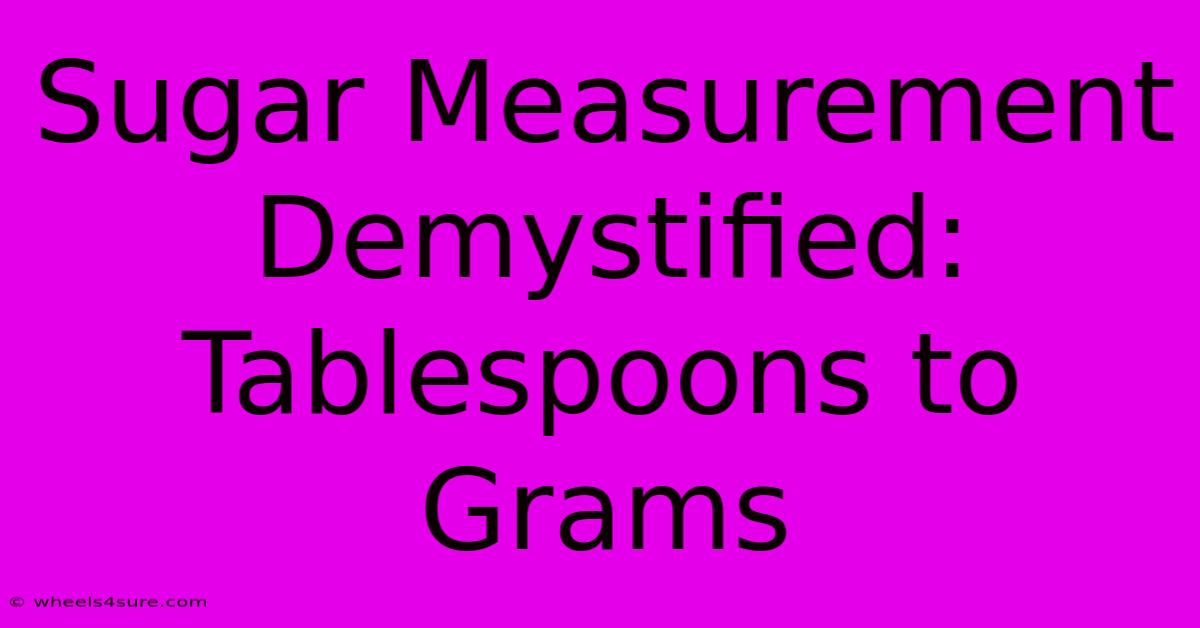Sugar Measurement Demystified: Tablespoons To Grams

Table of Contents
Sugar Measurement Demystified: Tablespoons to Grams
Are you baking a cake, whipping up a batch of cookies, or simply trying to follow a recipe that calls for a specific amount of sugar? Navigating the world of sugar measurements can be confusing, especially when recipes switch between tablespoons, teaspoons, and grams. This comprehensive guide will demystify the process, providing you with clear and accurate conversion tables and helpful tips for accurate sugar measurement. We'll explore why understanding these conversions is crucial for baking success and delve into the nuances of different types of sugar.
Why Accurate Sugar Measurement Matters
Accurate measurements are paramount in baking. Unlike cooking, where slight variations in ingredients often don't drastically alter the final product, baking is a precise science. Sugar plays a vital role in several aspects of baking:
- Sweetness: The obvious one! Too little sugar, and your baked goods will be bland. Too much, and they'll be overly sweet and potentially cloying.
- Structure: Sugar contributes to the structure of baked goods. It affects the browning, moisture, and overall texture. Incorrect measurements can lead to dense, gummy, or crumbly results.
- Leavening: Sugar interacts with leavening agents, influencing the rise and final volume of your baked goods. Inaccurate measurements can lead to flat or unevenly risen products.
- Moisture Retention: Sugar helps retain moisture in baked goods, contributing to a softer, more tender crumb.
Understanding Different Types of Sugar
Before we dive into the conversion tables, it's important to understand that different types of sugar have slightly different densities. This means that a tablespoon of granulated sugar will weigh slightly differently than a tablespoon of powdered sugar or brown sugar. While the differences are subtle, they can accumulate and impact your baking results, particularly in recipes that require precise measurements. Common types include:
- Granulated Sugar: The standard white sugar used in most recipes.
- Powdered Sugar (Confectioners' Sugar): Granulated sugar finely ground with cornstarch. Lighter and fluffier than granulated sugar.
- Brown Sugar (Light or Dark): Granulated sugar with molasses added, giving it a characteristic brown color and flavor. Dark brown sugar has a higher molasses content than light brown sugar.
Tablespoon to Gram Conversion Chart
The following chart provides approximate conversions for common sugar types. Remember, these are approximations. For the most accurate results, always use a kitchen scale.
| Sugar Type | 1 Tablespoon (approx.) | 1/4 Cup (approx.) | 1/2 Cup (approx.) | 1 Cup (approx.) |
|---|---|---|---|---|
| Granulated Sugar | 12 grams | 50 grams | 100 grams | 200 grams |
| Powdered Sugar | 10 grams | 40 grams | 80 grams | 160 grams |
| Light Brown Sugar | 18 grams | 70 grams | 140 grams | 280 grams |
| Dark Brown Sugar | 20 grams | 80 grams | 160 grams | 320 grams |
Important Note: These are average values. Slight variations can occur depending on the brand, packing density, and humidity.
Tips for Accurate Sugar Measurement
- Use a Kitchen Scale: The most accurate method for measuring sugar is using a kitchen scale. This eliminates the inconsistencies associated with volume measurements.
- Level Off: When using measuring cups, always level off the sugar with a straight edge to ensure consistent volume.
- Pack Brown Sugar: Brown sugar tends to pack down, so gently pack it into the measuring cup to ensure an accurate measurement.
- Don't Compress: Avoid packing granulated or powdered sugar, as this will lead to inaccurate measurements.
Conclusion: Mastering Sugar Measurement for Baking Success
Understanding sugar measurements is key to consistent and successful baking. By using a kitchen scale and understanding the differences between different types of sugar, you can significantly improve the quality and consistency of your baked goods. While conversion charts are helpful, remember they are approximations. For precise results, a kitchen scale is your best ally in the kitchen! Embrace accuracy and enjoy your baking adventures!

Thank you for visiting our website wich cover about Sugar Measurement Demystified: Tablespoons To Grams. We hope the information provided has been useful to you. Feel free to contact us if you have any questions or need further assistance. See you next time and dont miss to bookmark.
Featured Posts
-
Millie Bobby Browns Age Then And Now
Apr 02, 2025
-
Flow Gs Net Worth Learn From His Success
Apr 02, 2025
-
Dipika Kakars Daughters Health Update All Is Well
Apr 02, 2025
-
Is Kanye Wests Net Worth Inflated
Apr 02, 2025
-
Moms Amazing Life A Story You Wont Want To Miss
Apr 02, 2025
